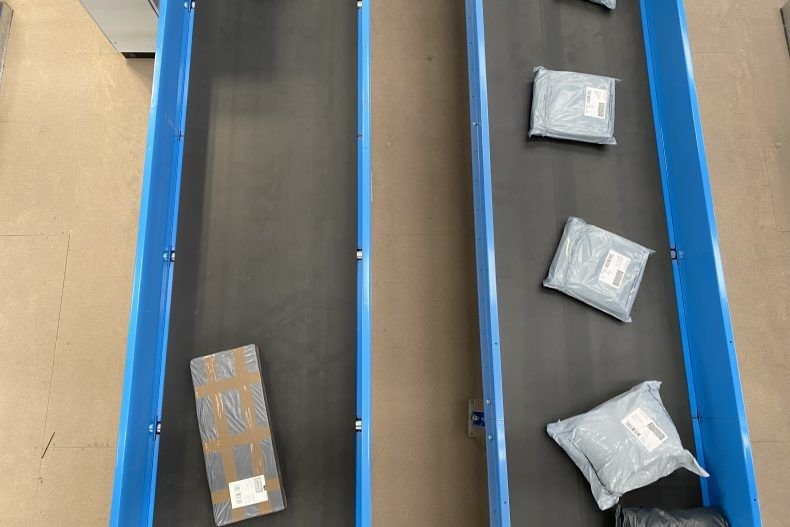They are revolutionising industries across the economy by supplying versatile and efficient automation solutions. Here is just a shortlist of the sectors that they are rending transformative change to:
Warehousing and Logistics Integration
AMRs are widely deployed in warehouses for material transport, order picking, and inventory management. They navigate autonomously, optimising routes, and streamlining operations. AMRs improve efficiency, accuracy, and speed in order fulfilment while reducing labour costs and minimising errors.
Manufacturing
In manufacturing facilities, AMRs assist in material handling, supply chain management, and assembly line operations. They transport raw materials, components, and finished goods, facilitating seamless workflow and reducing manual labour. AMRs contribute to lean manufacturing principles and enable flexible and agile production.
E-commerce and Retail
AMRs play a vital role in the e-commerce and retail sectors, particularly in fulfilment centres and distribution hubs. They automate the process of order picking, consolidation, and packaging, enabling faster and more accurate order processing. AMRs improve warehouse productivity, support high-volume operations, and enhance customer satisfaction through efficient order fulfilment.
Transportation and Warehousing
AMRs are employed in transportation and logistics operations for last-mile delivery, parcel sorting, and warehouse management. They optimise package routing, reduce delivery times, and increase efficiency in the logistics chain. AMRs contribute to streamlined operations, cost savings, and improved customer satisfaction in the transportation sector.
As demonstrated, AMRs have a myriad of applications in various sectors of the economy. From warehousing and manufacturing to healthcare, agriculture, hospitality, and beyond, AMRs create flexible and efficient automation solutions. They improve productivity, accuracy, and safety while reducing costs and enhancing customer experiences. As the technology continues to advance, the potential for AMR deployment across industries is vast, transforming the way we work and operate in the modern world.
How Does AMR Systems Interact with the Rest of Your Automated Warehouse
AMR systems interact with other elements of automated warehouses to increase overall efficiency by optimising workflows, improving accuracy, and streamlining operations. Here’s how they integrate with key components of warehouse automation solutions:
Warehouse Management Systems (WMS) Integration
AMR systems seamlessly integrate with WMS, the central control hub of a warehouse. Through APIs and data exchange protocols, the robots receive real-time instructions from the WMS and communicate critical information back. This integration enables dynamic task allocation, efficient resource utilisation, and enhanced visibility into warehouse operations. The WMS assigns tasks to the robots based on priority, optimising their movements and ensuring efficient task execution.
Navigation and Pathfinding
AMR systems utilise advanced sensors like lidar, cameras, and even laser scanners to create detailed maps of the warehouse environment. These maps serve as a reference for the robots’ navigation. The robots continuously scan their surroundings, detect obstacles, and plan optimal paths to move goods or perform tasks. By navigating autonomously, AMRs can avoid congestion, optimise travel routes, and adapt to changes in the warehouse layout. This ensures smooth and efficient movement throughout the facility.
Collaborative Workflow
AMR systems work alongside human workers to create a collaborative workflow. The robots autonomously transport goods to designated workstations, where human workers perform tasks like picking, packing, or quality control. By offloading the burden of material transport, the robots free up human workers to focus on value-added activities. This collaboration increases overall efficiency, reduces errors, and improves productivity.
Inventory Management
AMR systems contribute to accurate inventory management in automated warehouses. Equipped with sensors, they can scan barcodes or RFID tags on shelves or products to track inventory levels. This real-time data is relayed to the WMS, allowing for precise inventory tracking and minimising the risk of stockouts or overstocking. By automating inventory checks and updating inventory information, AMR systems streamline the replenishment process and enable efficient order fulfilment.
Task Optimisation
AMR systems optimise task execution by leveraging intelligent algorithms. They can dynamically adapt to changing priorities, workload distribution, and time-sensitive tasks. By optimising the order in which tasks are executed, the robots reduce idle time and ensure timely completion of critical operations. This optimisation results in improved throughput, reduced bottlenecks, and enhanced overall efficiency of the warehouse automation solution.
Real-time Monitoring and Analytics
AMR systems provide real-time monitoring and analytics capabilities. Warehouse managers can track the performance of individual robots, monitor task progress, and gather valuable data on key performance indicators. This data-driven approach allows decision-makers to identify operational inefficiencies, optimise workflows, and allocate resources effectively. By leveraging insights from AMR analytics, warehouses can continuously improve their automation solutions, maximising efficiency over time.
In summary, AMR systems interact with various components of automated warehouses, including WMS, navigation systems, human workers, inventory management, task optimisation, and real-time monitoring. By seamlessly integrating with these elements, AMR systems enhance overall efficiency by optimising workflows, improving accuracy, and streamlining operations in warehouse automation solutions.
Why work with L-A-C Logistics Automation for Your AMR Solution?
In this era of highly complex warehouse automation solutions, L-A-C Logistics Automation is proud to offer elegant AMR solutions that provide flawless integration transforming labour-intensive traditional warehouses into highly efficient and productive environments. Keeping our clients’ operations ahead of the curve with their advanced navigation capabilities, flexibility, collaborative workflow, integration with WMS, and real-time monitoring and analytics contributing to our clients’ optimised warehouse solutions and continued success.
With our emphasis on aftercare and turn-key solutions design you can be confident that investing in our AMR systems is not just about adopting the latest technology—it’s about embracing transformative solutions that empower warehouses and logistics operations to meet the demands of the modern supply chains. With these intelligent robots seamlessly integrated into your warehouse automation solutions, you can unlock new levels of efficiency, productivity, and success.
So, are you into logistics and warehousing operations and in need of seminal change? Get in touch with us for your warehouse automation solutions today!


